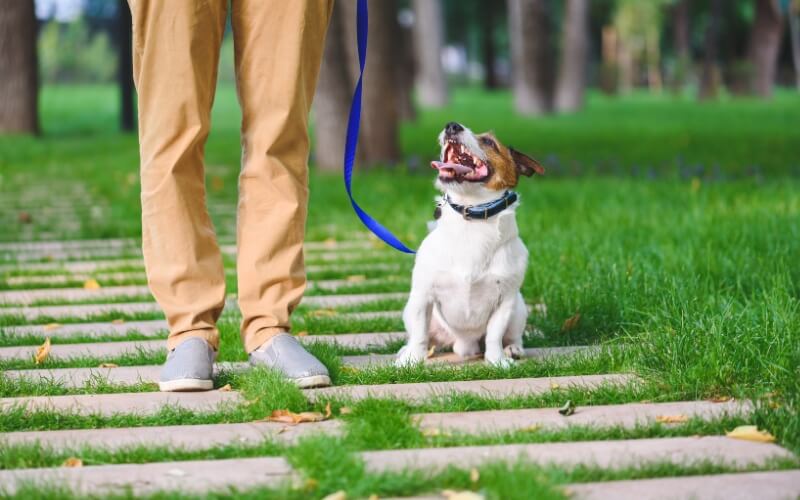WHY is my dog aggressive on lead
If you’re a dog owner you’ll almost certainly have encountered this scenario. You’re on a walk with your dog and another dog approaches, on a lead. As you get closer, the dog starts to whine, jump up and down and lunge at you. The dog may even growl, bark or bare his teeth. It’s a bit scary, right? For both you and your dog.
In most cases the owner of the dog will be apologetic, maybe yanking their dog back, possibly shouting at it and feeling quite embarrassed. Maybe you’re even the owner whose dog reacts in this way to other dogs?
In this post we’re going to look at the reasons why dogs behave in this way. As with any behaviour we want to change, it’s really important to understand the why, before we look at how to attempt to change it (that’s the focus of my next post!)
Naturally, most people believe that a dog is being ‘aggressive’ (although that is a label and we look at behaviour rather than labels) when he or she displays these kinds of behaviours. The first thing we need to understand is that the lunging, barking, growling and whining at other dogs or people is usually based on fear (but not always).
Many dog professionals call this ‘reactive behaviour’ as your dog is over-reacting to something in the environment. When a dog behaves like this they are able to keep the things that scare them – other dogs and people – away. This usually works for them – most people take a wider path around a dog that is displaying these behaviours.
So the growling, barking and lunging serve a purpose for the dog, it works at getting the scary thing away from them.
Fight or Flight
When a dog is scared, they have several options including ‘fight or flight’ mode. But when they get scared and are on a lead, the ‘flight’ option has been removed. Even if they are not usually ‘over-reactive’, a dog that is on leash is physically trapped. The dog’s options are limited and his or her choices are severely restricted. Basically, the dog has no choice but to walk past people he/she may be absolutely petrified of.
In fact, if a dog puts the brakes on, the owner will often drag them by the leash and collar over to a dog or person to ‘say hello’. The dog is constantly forced into situations they do not want to be in and that creates fear. Imagine someone dragging you over to a snake to say hello if you are petrified of them.
Off leash, the dog has the choice to run away from the scary thing.
How Not to Deal with ‘Aggressive/Over-Reactive’ Behaviours in Dogs
Aggressive or over-reactive behaviours are the last thing we as owners want to see in a dog. More often than not, you will see owners punishing their dogs for barking at other dogs or people walking by, but this makes things worse for the dog (and the owner). It always saddens me when I see owners yelling at, hitting or yanking their dog’s lead when this situation occurs. The growling or barking is their dog’s cry for help. Punishing it will simply make it worse and erode the trusting bond a dog has with their owner.
I can fully appreciate and understand that it is extremely frustrating for people who have dogs that display these behaviours. They feel embarrassed because other people might pass judgment on them and their dog. I have heard onlookers yell out to the dog owner things like ‘get your dog under control’, ‘your dog is aggressive’, ‘your dog is a psycho’, ‘don’t bring your dog here again, he goes nuts’ and more.
If your dog behaves in this way there can be feelings of disappointment, despair, disillusionment, frustration and anger that you can’t just go for a nice walk without your dog going nuts when they see another dog or person. Check in next time and I’ll be exploring what we can do as dog owners to help eliminate this behaviour. Right now, I’m going to explain a few more reasons why it might happen.

Contributing Factors to Aggressive/Reactive Behaviours in Dogs
Many people want to know why their dog displays reactive or aggressive behaviour. Unfortunately, we can’t ask the dog but we can examine some components that may have contributed to the behaviour manifesting.
Lack of socialisation
In Australia, we have become a society that restricts a dog’s life. In years gone by, dogs were allowed to roam the streets. They knew where they lived but had access to play with the dogs down the road, to go and join the neighbourhood kids on a bike ride and generally be involved in the everyday world. Slowly, our nanny state decided it was best to put in rules and regulations around where dogs were allowed and not allowed to be. This became more and more restrictive, which resulted in the situation we have today. A country which does not allow dogs on public transport, in shopping centres, restaurants or cafes, on ovals, most beaches or lakes and certainly a society where dogs must be restrained on leash at all times unless in a designated off leash area. The problem with this is that it restricts a vital element to a dog’s development – exposure to the world around them.
In today’s society, we also lock puppies up until they have had their last vaccination around 16 weeks, even though there has been years of education to advise owners there is another way. Owners can expose their puppies whilst keeping them free of diseases at the same time.
Some dogs in Australia are locked up in the backyard. By the time the dog actually goes out into the real world (maybe at 1-year old, some 3-years old, some never) their key social processing periods have already passed. Therefore, to these dogs the world is a scary place full of scary things. Even things which should be completely normal to them like other dogs and humans (including children) are a source of fright.
These things are scary because they have not been exposed to them in their key social processing periods. So of course they are going to display behaviours such as barking, lunging and growling. The fear they feel in these situations is very real for them.
Genetics
Another factor that can contribute to ‘over-reactive behaviours’ is genetics. Unfortunately, we have many backyard breeders in Australia who think it’s a good idea to breed their dog with the neighbour’s dog. They take no consideration of the dog’s temperament, their physical structure or conformation and will breed dogs that may be anxious, afraid, suspicious or reserved.
A further problem is that humans have also bred dogs over thousands of years to actually be like this. Some of the herding and guarding breeds do not like strangers and they are highly sensitive and anxious. They are wary of anyone who is unknown and for good reason. They are there to protect, guard and alert their owners to any small changes in the environment. If you can understand what your dog was bred for, the dog’s history and characteristics, it will give you valuable information on how they may behave.
Bad Experiences
Sometimes, the dog’s past experiences may contribute to the current behaviour. Maybe every time the dog was taken out, he saw another person or dog and pulled towards them to say hello. Maybe, the owner hit the dog every time this happened, or sprayed them in the face with water, or choked them with a check chain. Eventually the dog came to associate people or dogs with something bad happening to him.
Another common bad experience is leash greetings gone wrong. In the past when the dog has met other dogs on lead, they may have bitten him and/or severely traumatised him and now he is terrified of other dogs.
So now, the dog has a negative association at the sight of new people and dogs. Eventually the dog becomes more and more reactive. While aversives such as a shock collar may suppress the behaviour, the emotion behind the behaviour – fear – becomes much worse. It may get to the point where it escalates and the dog may bite another person or dog because he/she is so scared and feels the needs to defend themselves. Remember that suppressing a behaviour is not changing behaviour.
Another factor with some dogs is that they may have suffered physical abuse in their home or were isolated for years in a den or garage. Again, the dog is going to have negative feelings towards other people if this has happened.
Frustration due to restraint
Off leash, dogs would have the choice to approach (or not approach) another dog to play. They have the ability to naturally move as they wish to approach a dog. On leash, when a dog is consistently restricted from attempting to greet or play with another dog, excitements quickly turns into frustration. Sometimes a dog may be allowed to greet another dog but then gets suddenly dragged off.
Frustration doesn’t only just happen on a lead walk. It happens with barriers such as dogs inside the house looking out of a window at other dogs, dogs behind fences (including electric or invisible fences, crates and kennels). When high levels of arousal and frustration come together, it can cause the dog to go into a state of rage.
There has been research to show that dogs who are confined and only given walks on leash became much more frustrated than dogs who were able to act naturally with no leash restrictions.
I have a friend who owns a dog with severe dog over-reactivity. This dog was a stray for almost 2 years before she was adopted. She spent two years doing whatever she wanted, roaming the streets, sometimes spending several weeks with people who fed her. When she is on leash now, she becomes extremely aroused and frustrated because she is restricted from doing what she pleases.
In Summary
A dog’s ‘aggressive’ or ‘over-reactive’ behaviour on lead can manifested in several ways. We always need to remember that most of the time, the primary reason for those behaviours occurring is fear (but not always).
As owners we can make our lives and our dog’s lives easier by addressing the emotion behind the behaviour, avoid using any sort of punishment and prevent any further bad experiences from happening to the dog.
If you have a dog who is sensitive to other dog’s on lead, please get help straight away!
Check in next time when I’ll be explaining ‘WHAT you can do to manage a dog displaying aggressive behaviours on lead.’
Dogaholics Dog Training and Behaviour Services

